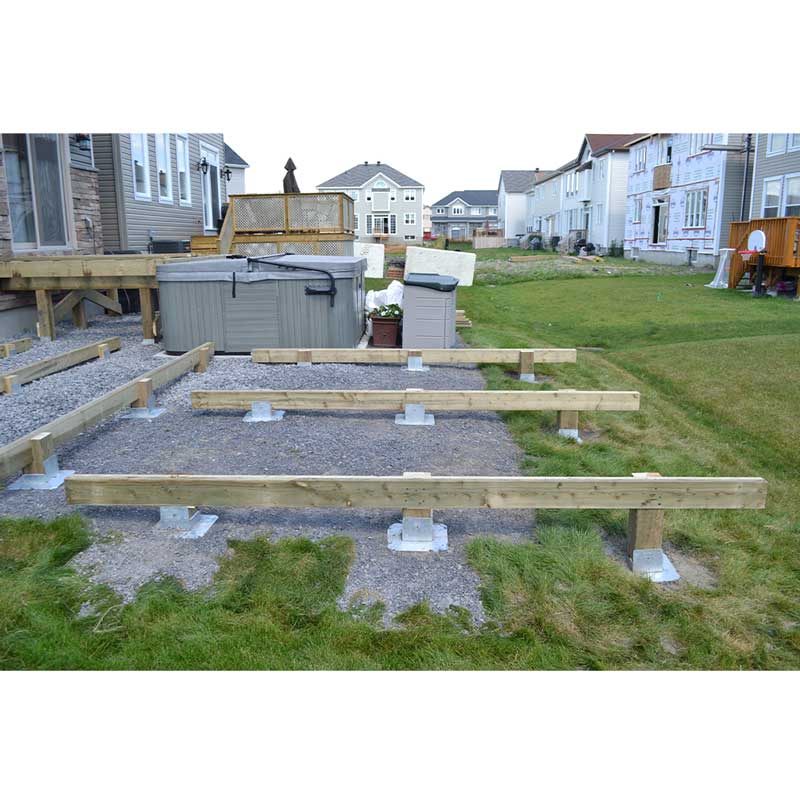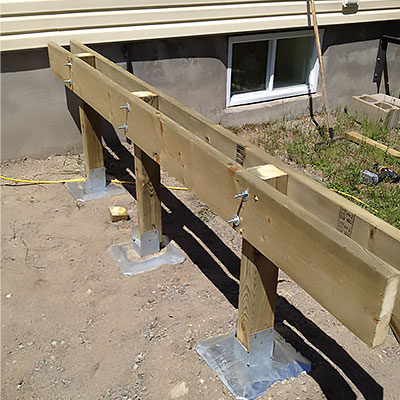A Solid Structure for Your Sanctuary: Checking Out the Relevance of Deck Footings in Outdoor Structures
A Solid Structure for Your Sanctuary: Checking Out the Relevance of Deck Footings in Outdoor Structures
Blog Article
Choosing the Right Deck Footings for Security and Resilience
When it concerns building a deck, among one of the most essential choices you will make is selecting the ideal footings for stability and durability. The durability and safety of your deck depend heavily on the sort of footings you pick, as they offer the crucial support and security to stand up to the examination of time. With a myriad of choices available, it can be frustrating to establish which footings are best matched for your details requirements. In this conversation, we will certainly discover the various kinds of deck grounds, think about the essential aspects to consider when making a decision, and explore the advantages and disadvantages of different options. By the end, you will have a clearer understanding of the selections handy and be far better equipped to make an informed decision for your deck task.
Sorts Of Deck Footings
These grounds consist of a cylindrical hole filled up with concrete, which offers a solid foundation for the deck posts. Concrete pier footings are fairly very easy to install and offer exceptional security, making them a popular choice for numerous deck tasks.
Another kind of ground is the helical stack ground. Helical heaps are steel shafts with helical plates affixed to them. These grounds are mounted by screwing them right into the ground, which creates a safe and secure structure for the deck. Helical heap footings are perfect for locations with tough soil conditions, as they can be mounted in almost any sort of soil. They also enable simple modification and leveling of the deck if required.
Additionally, some contractors select precast concrete grounds. These footings are constructed from long lasting concrete and come in different sizes and shapes to suit different deck layouts. Precast concrete grounds are hassle-free to install and supply a secure base for the deck framework.
Ultimately, one more option is the post-in-anchor footing system. This type of footing entails driving a metal support into the ground and attaching it to the deck post. It provides adaptability in terms of positioning the deck articles and appropriates for decks with lightweight structures.
When selecting the ideal sort of deck footing, it is necessary to think about aspects such as dirt conditions, deck lots, and regional building ordinance (Deck Footings). Consulting with a specialist contractor or architectural designer can aid make sure the proper footing is chosen for a risk-free and stable deck
Variables to Take Into Consideration When Choosing Footings
When choosing the proper grounds for a deck, it is critical to carefully take into consideration various variables such as soil conditions, deck tons, and adherence to regional building regulations. These aspects play a considerable role in ensuring the stability and resilience of the deck framework.
Among the main variables to consider is the soil problems. The type of soil on which the deck will be developed identifies the kind of footings needed. Decks constructed on sandy or loosened soils might require deeper footings to supply ample assistance and stop settling. On the other hand, decks constructed on clay or extensive dirts might need grounds that can suit the soil's tendency to increase and contract.
An additional crucial factor is the deck load. The weight of the deck, including the materials utilized and any kind of potential online lots such as furniture or celebrations, should be taken into consideration when choosing footings. The grounds have to be designed to bear the weight of the deck and disperse it equally to stop any kind of structural concerns or failures.
Lastly, adherence to local structure codes is vital. Building ordinance differ from region to area, and it is necessary to abide by the certain requirements established by the regional authorities. Deck Footings. These codes make certain that the deck is constructed securely and fulfills the necessary standards for architectural stability and load-bearing ability
Concrete Grounds: Disadvantages and pros

When utilized as the structure for a deck,Concrete grounds supply several advantages and downsides. On the silver lining, concrete footings provide superb stability and longevity. Concrete is a inflexible and strong product that can support hefty lots and withstand numerous climate condition. It also has a long lifespan, making it a trustworthy selection for long-term use.
Another advantage of concrete grounds is their versatility. They can be put right into different sizes and shapes to fit numerous deck layouts and setups. Concrete footings can be tailored to fit the details demands and demands of the deck structure.
Nonetheless, there are likewise some disadvantages to making use of concrete grounds. This can increase the total price of the deck job and might call for expert assistance.

Helical Piers Vs. Sonotubes: Which Is Better?
In considering the structure options for a deck, the contrast in between helical piers and sonotubes my blog is essential in determining the remarkable choice. Helical piers, likewise called screw piles, are steel shafts with helical plates affixed to them. They are turned right into the ground making use of hydraulic machinery, offering a resilient and stable foundation for the deck. On the various other hand, sonotubes are round types constructed from cardboard or fiber product that are full of concrete. They are placed in an opening explored the ground and give assistance for the deck.
The helical plates on the piers produce a solid hold with the soil, stopping any movement or changing of the deck. Sonotubes, on the other hand, count only on the concrete loading for stability, which might not provide the very same level of toughness and resistance.
In regards to installation, helical piers are relatively less complicated and faster to install contrasted to sonotubes. The hydraulic machinery used to twist the piers into the ground guarantees a efficient and quick process. Sonotubes, on the other hand, need excavating openings and pouring concrete, which can be labor-intensive and lengthy.
In addition, helical piers are a more versatile alternative. If needed, they can be used in numerous dirt conditions and can be adjusted or reinforced. Sonotubes, on the various other hand, might call for added support, such as rebar, in certain dirt conditions or areas with high lots needs.
Picking the Right Footings for Your Deck's Dimensions
For optimal structural honesty, it is necessary to carefully select the suitable footings that line up with the dimensions of your deck. The dimensions of your deck, including its width, size, and height, play a substantial duty in figuring out the kind and dimension of grounds required.
When selecting footings for your deck, it is necessary to think about the load-bearing ability of the dirt. more helpful hints The weight of the deck, integrated with the weight of any kind of furnishings or individuals on it, puts in a substantial pressure on the grounds (Deck Footings). As a result, it is important to pick footings that can adequately sustain this weight without changing or sinking over time.
Larger decks with greater measurements require bigger grounds to supply sufficient security and support. The form of the grounds, whether they are rounded or square, depends on the style and layout of the deck.
Final Thought
In final thought, picking the right deck footings is important for making certain security and longevity. Elements such as the type of footings, the deck's dimensions, and the pros and cons of different choices need to be considered.
These footings consist of a cylindrical hole filled with concrete, which offers a solid foundation for the deck messages. Concrete pier footings are fairly simple to set up and use exceptional stability, making them a prominent option for lots of deck jobs.
Precast concrete footings are practical to install and supply a steady base for the deck framework.
It supplies versatility in terms of placing the deck blog posts and is appropriate for decks with lightweight structures.
Concrete footings use a number of look at more info advantages and disadvantages when made use of as the structure for a deck.
Report this page